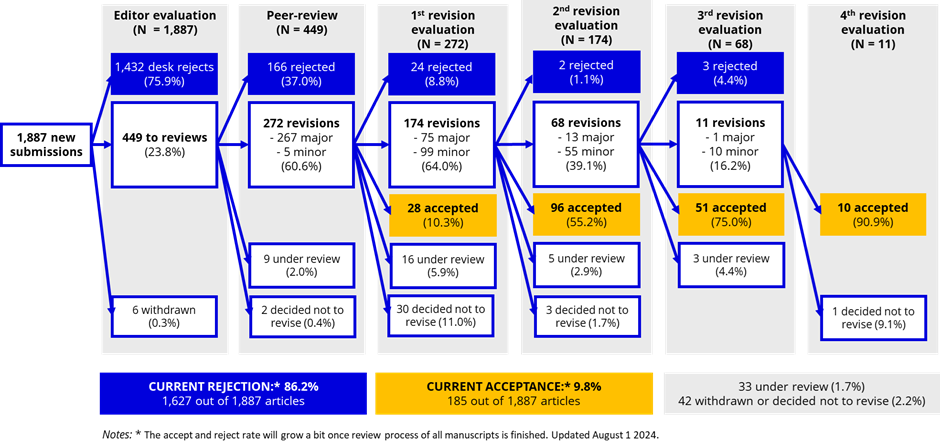Decisions and Reviews Statistics for 2023
We're excited to share the latest insights from our journal's submission and decision statistics. This annual update provides a detailed look at the trends and changes over the past year. In this post, we'll present the data from 2023, compare it with previous years, and discuss the patterns we've observed in submissions, decisions, and reviews.
As always, our focus is on transparency and keeping the academic community informed. While some submissions from 2023, particularly those sent to external reviewers, are still pending final decisions, we'll also provide a broader perspective and timeframe to offer a more complete picture of the current state of submissions and decisions.
Submission and Decision Statistics: 2023
In 2023, we received 435 submissions, representing an 8 percent increase from the previous year. After submission, each manuscript undergoes an internal review by our journal's editors, who assess whether the manuscript fits our scope and meets the basic quality standards. This internal evaluation determines whether the manuscript will be sent to external reviewers for a more in-depth review. As you can see in Figure 1, the increase in submissions was also related to an increase in our desk reject rate, resulting in fewer submissions sent to external reviewers. As you will see below, this slowly growing trend of increasing desk reject rate is also connected to a decrease in articles rejected after reviews from external reviewers. In other words, we selected higher-quality papers for the review process. This means that when the article is sent to external reviewers, the authors have a higher chance of publishing it in our journal.
Figure 1. Submissions and Initial Decisions in 2019-2023.

Specifically, the desk reject rate in our journal in 2023 was 81 percent (all submissions from 2023 have finished the initial evaluation). This number includes submissions rejected for reasons related to the study’s quality, as well as submissions that were out of scope or those with detected plagiarism issues (in 2023, this concerned 2.5 percent of submissions).
About 35 percent of the 83 (n = 29) submissions sent to external reviewers in 2023 are still being reviewed or revised, pending a final decision. Therefore, instead of focusing solely on 2023, we use data from the last five years (2019-2023, N = 1,887) to comprehensively illustrate a typical journey of articles through the review process. As shown in the simplified Table 1, the overall decision rates have remained relatively stable, but the acceptance rates among articles sent to external reviews increased between 2019 and 2022 (where we know the final decision for most articles). Data from 2023 is not very informative in this regard, and the percentages should be interpreted cautiously. For instance, most of the submissions are rejected after the first round of reviews (this phase is finished for most 2023 submissions). In contrast, in subsequent review rounds, articles are accepted more often. This means that once all 2023 submissions are decided, the percentage of accepted will grow while the percentage of rejected articles will likely decrease.
Table 1. Decisions for Articles Submitted in 2019-2023.

Figure 2. Decisions for Articles Submitted in 2019-2023 in Each Review Round.

Figure 2 illustrates the review process flow and shows several key aspects that remain stable over the years (see also our decision and review statistics from 2022 and 2021). It is common for articles to go through several rounds of evaluation. Specifically, each accepted article went through at least one round of revisions (usually major), but most go through two or three rounds before they are accepted.
When manuscripts are rejected after being sent to external reviewers, it happens most often after receiving the first reviews, which was the case for 37 percent of articles that went through a first round of peer review. Unfortunately, some manuscripts are rejected after a second or even third revision, although these rejections are rare. Altogether, between 40 and 50 percent of the manuscripts that go to peer review are eventually rejected, but as noted above, this number has been decreasing lately (Table 1).
It is also not uncommon for authors to decide not to submit their revised manuscript and withdraw it. These withdrawals, however, present only a small percentage (2.2 percent) of the articles.
Finally, about one-tenth of the submitted articles are accepted, and this proportion oscillates only a little between years (Table 1). This acceptance rate reflects our commitment to maintaining high standards of quality and relevance in the work we publish. While the percentage may seem modest, it underscores the rigour of our review process and our dedication to ensuring that each published article makes a meaningful contribution to our field.
Decision Length
The decision length can be important information for authors submitting to our journal. It provides insights into the complex and meticulous nature of the review process. Understanding this timeline can help authors set realistic expectations and, as we hope, also appreciate the thoroughness involved in evaluating submissions. As the decision length can be counted in many different ways, we decided to present two statistics, as in the previous years, that illustrate the process meaningfully.
Firstly, it is the time from submission to the initial decision (i.e., desk reject/sent to peer review) made by the editor in charge of the manuscript. In 2023, the initial decision took, on average, 18.3 days (Me = 10; Mo = 2 and 5). The average number of days slightly increased from the previous year. More than half of the decisions were made in 10 or less days.
Secondly, it is the time period covering the days from submission to the decision after the first review round, usually the most demanding period. Several steps are included in this timeline - the editor’s initial decision, searching for available reviewers, waiting for their reviews, and the editor’s evaluation based on the reviews. Thus, this metric applies only to manuscripts sent to external reviewers where we have already received the reviews and the editor has made a decision (74 out of 83 articles submitted in 2023). On average, it took almost five months - 147.6 days (Me = 139, multiple modes) for authors to receive the “after reviews” decision.
Please note we chose not to present the decision length from submission to the final reject/accept decision because this period is influenced by the number of review rounds, which, as shown in Figure 2, can range from one to four. It also highly depends on the amount of time authors need to revise their manuscripts and resubmit. As a result, the average duration from submission to final decision is less interpretable due to the variability in the review process.
Reviewer Statistics
To make a decision, we require a minimum of two high-quality reviews per article. As mentioned earlier, searching for willing reviewers is a particularly demanding task that has unfortunately intensified recently. To receive enough quality reviews, we had to contact 1,245 reviewers in 2021 (for 104 articles), 2,097 reviewers in 2022 (for 91 articles), and 2,183 reviewers in 2023 (for 83 articles). This translates into 26.3 review requests per article in 2023 (with a large variance, Min = 4, Max = 79, Me = 24, and multiple modes). This number is already higher than in 2022 (M = 23) and much higher than in 2021 (M = 12) and will still grow since not all 2023 submissions have finished the first round of reviews.
Upon receiving our invitation, the reviewers have the option to accept it or decline it. Out of the 2,183 review requests in 2023, about one-third (32.3 percent) declined our invitation, and only about one-tenth (11.7 percent) accepted it. In total, over a half (54.8 percent) of the approached reviewers did not respond to our invitation (neither declined nor accepted), and a small percentage (1.2 percent) of reviewers accepted the invitation but never delivered the review (the percentage translates into one-tenth of those who accepted the review request initially). This usually happens without prior notice and explanation. We saw a similar trend in 2022 when finding reviewers willing to accept review invitations was more challenging. In addition to the reviewers who never deliver the promised review, some of the reviews are unfortunately not helpful for the editor’s evaluation and are not sent to the authors due to their low quality, leading to the need to approach new reviewers while prolonging the time authors are waiting for decisions. In 2023, the editors rated about 15 percent of received reviews as having poor quality (1 or 2 points out of 5 points maximum for review evaluation). Such reviews typically do not address the manuscript's specific topic and fail to provide concrete critique or actionable advice; they are often very short and consist only of general proclamations.
We also see that reviewers tend to need more time to write the reviews. We usually ask reviewers to deliver their reviews within four weeks (or six weeks during summer and winter vacations). In 2023, 42 percent of reviewers who delivered their reviews did this on time (i.e., within four weeks). Most reviews (70 percent) are then delivered within 40 days of the review invitation with the help of friendly reminders. We are also open to prolonging the deadlines when the reviewers ask us to do so, as we prioritise review quality over speed. If you are a reviewer, do not hesitate to ask us for more time to complete your review if needed.
We also aim to contact the original reviewers for the next review rounds. Unfortunately, only 56 percent of reviewers accepted our invitation to review a revision and delivered the review. This number decreases over the years (57.4 percent in 2022 and 82.8 percent in 2021). This downward trend highlights the growing challenge of securing consistent and reliable reviewers, which impacts the efficiency of our review process. It also often results in a prolonged waiting time for the authors, as in some cases, new reviewers must be approached at these stages.
Concluding Remarks
We ended last year’s post about decisions and review statistics with concluding remarks about the increased challenges of the review process, including the need to approach more reviewers and extended review and decision periods. Sadly, this trend continued also in 2023, although - luckily - we do not see as dramatic changes as we saw between 2021 and 2022. Nevertheless, our commitment to maintaining a thorough and quality review process remains strong. We still aim to obtain at least two quality reviews with constructive feedback from the experts on the topic for each article.
We deeply appreciate the dedication of reviewers and editors who contribute their time and expertise to assess manuscripts and offer valuable feedback. It is also their efforts that are crucial to maintaining the integrity of the review process.
We also extend our gratitude to the authors for their patience and understanding during this period. Despite the extended timelines, it remains our priority to support authors throughout the review process and guide their work toward successful publication.
Lenka Dedkova, Marie Jaron Bedrosova, and Vojtech Mylek
